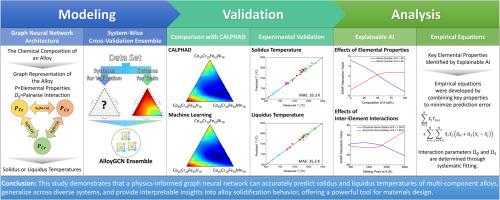合金系统中凝固的可解释和物理信息建模:多组分预测的广义框架
IF 8.3
1区 材料科学
Q1 MATERIALS SCIENCE, MULTIDISCIPLINARY
引用次数: 0
摘要
本文介绍了一种基于图的神经网络AlloyGCN,用于高精度、可解释性地预测多元素合金的固液温度。利用节点和边捕获元素属性和相互作用的图表示,alloy gcn有效地概括了不同的合金成分,包括看不见的系统,同时比传统的热力学方法需要更少的数据。各种合金系统的实验验证证明了该模型的可靠性,实现了与CALPHAD计算相当的预测精度。可解释的人工智能技术的集成为影响预测的物理因素提供了有价值的见解,推导出的经验方程为合金设计提供了实用工具。通过将先进的机器学习与可解释的框架相结合,这项工作有助于开发高效可靠的合金性能预测和材料发现方法。本文章由计算机程序翻译,如有差异,请以英文原文为准。


Interpretable and physics-informed modeling of solidification in alloy systems: A generalized framework for multi-component prediction
This study introduces AlloyGCN, a graph-based neural network designed to predict the solidus and liquidus temperatures of multi-element alloys with high accuracy and interpretability. Leveraging a graph representation where nodes and edges capture elemental properties and interactions, AlloyGCN effectively generalizes across diverse alloy compositions, including unseen systems, while requiring less extensive data than traditional thermodynamic methods. Experimental validation across various alloy systems demonstrated the model's reliability, achieving predictive accuracy comparable to CALPHAD calculations. Integration of explainable AI techniques provided valuable insights into the physical factors influencing predictions, and derived empirical equations offer practical tools for alloy design. By combining advanced machine learning with interpretable frameworks, this work contributes to the development of efficient and reliable methods for alloy property prediction and materials discovery.
求助全文
通过发布文献求助,成功后即可免费获取论文全文。
去求助
来源期刊

Acta Materialia
工程技术-材料科学:综合
CiteScore
16.10
自引率
8.50%
发文量
801
审稿时长
53 days
期刊介绍:
Acta Materialia serves as a platform for publishing full-length, original papers and commissioned overviews that contribute to a profound understanding of the correlation between the processing, structure, and properties of inorganic materials. The journal seeks papers with high impact potential or those that significantly propel the field forward. The scope includes the atomic and molecular arrangements, chemical and electronic structures, and microstructure of materials, focusing on their mechanical or functional behavior across all length scales, including nanostructures.
 求助内容:
求助内容: 应助结果提醒方式:
应助结果提醒方式:


